What I'm Reading: June 2024, With Commentary
June 19, 2024 at 5:14 PM
Here are the books, with Commentary that I’ve read and most admired in recent months, November 2023-June 2024. The commentary at the end of this post is “The Pleasure of Honoring and Rereading a Favorite Author.”
- The Vulnerables by Sigrid Nunezi, fiction
- Democracy Awakening: Notes on the State of America by Heather Cox Richardson, nonfiction narrative
- Instructions for a Heatwave by Maggie O’Farrell, fiction
- The Upstairs Delicatessen-on-Eating, Reading, Reading-About-Eating, and Eating-while-Reading by Dwight Garner, memoir on books and food
- Winter Solstice by Nina McLaughlin, essay
- Loved and Missed by Susie Boyt, fiction
- The Comfort of Crows: A Backyard Year by Margaret Renkl, essays
- How to Know a Person: The Art of Seeing Others Deeply and Being Deeply Seen by David Brooks, nonfiction, advice.
- How to Become a Better Writing Teacher by Carl Anderson and Matt Glover, professional
- KING: A Life by Jonathan Eig, biography
- Lucy Gayheart by Willa Cather, fiction
- James by Percival Everett, fiction
- The Magic of Reality: How We Know What’s Really True by Richard Dawkins, nonfiction on wonders of science
- Nourishing Caregiver Collaborations: Elevating Home Experiences and Classroom Practices for Collective Care by Nawal Qarooni, professional
- Somehow: Thoughts on Love, by Anne Lamott
- Birds of America by Lorrie Moore
- Table for Two by Amor Towles, short stories
- On Living by Kerry Egan, memoir
- Between Two Kingdoms: A Memoir of a Life Interrupted by Suleika Jaouad, memoir
While I highly recommend all the books on the list, I especially want to call out a book of fiction (Loved and Missed) a biography (KING: A Life), short stories (Table for Two), a memoir (Between Two Kingdoms,) and a professional book (Nourishing Caregiver Collaborations.) While I found all of the books on the “What I’m Reading” list to be excellent, these five especially impacted me and resonated for their extraordinary writing, storytelling, and inspired thoughts a great book can bring us. Also, taking author’s prerogative, I want to call out my latest book, which came out about the same time as the previous “What I’m Reading” list was published. The Heart-Centered Teacher: Restoring Hope, Joy, and Possibility in Uncertain Times. (Routledge, 2024) is about the necessary intersection between teaching, learning, and living and is based on my fifty plus years of teaching, living, researching, experiencing, and facing the challenges and joys of life. You can find complete information on my book and the companion website with online resources at www.regieroutman.org. As well, since this posting is occurring around the beginning of summer, where you might have more time to read, do check out the “What I’m Reading” archives—which date back to 2012—for highly recommended books and for Commentaries on teaching, learning, and living.
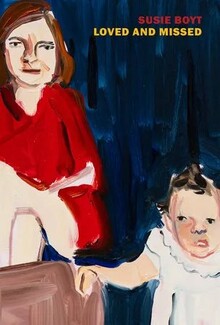
Loved and Missed by Susie Boyt is my favorite book of fiction in the past year. It’s a poignantly written, unforgettable story of a family and how they are—and are not—bound together. The main characters are Ruth, a mother and grandmother; Lily the granddaughter she raises; and Eleanor, Ruth’s drug addicted daughter. It’s a beautifully written book about the curative powers of love and about loving someone through very tough times, even if that love is not reciprocated. It’s about the loving relationship between a grandmother and a granddaughter and how they live their lives together with simple and joyful pleasures. It’s about respecting the dignity of a complicated, loved one and life as a balancing act that requires compassion and understanding.
New York Book Review notes “Love and Missed is a whip-smart, incisive, and mordantly witty novel about love's gains and missteps. British writer Susie Boyt's seventh novel, and the first to be published in the United States, is a pitch-perfect work of art.” I agree. This powerful story, with its sensitively rendered characters, has never left me. See, Los Angeles Review of Books for outstanding book review, and listen to podcast interview with the author at Our Shelves: Heroics with Susie Boyt for more information on the book and its author.
If I had to choose one of the most impactful and important books I’ve read since my last posting of “What I’m Reading,” KING: A Life by Jonathan Eig would be at the top of the list. I bought the book after I heard and read raves about it. Then, intimidated by its size, I promptly put it on my bookshelf where it sat for months with its big, bright yellow spine-- with KING writ large on it-- and its heft of over 600 pages. Then, thankfully, my curiosity got the better of me, and I picked it up. Do not be put off by the size! This book is the first comprehensive biography of Martin Luther King Jr.in 35 years and is the most thoroughly researched book written detailing the life, times, and legacy of the civil rights activist. Eig conducted extensive interviews with people who knew Martin Luther King well—advisers, friends, family, people he worked with, and many more The book’s extensive documentation includes newly uncovered research including recently declassified FBI files plus 70 pages of Notes at the end plus a 30-page Index. Yet, the book doesn’t read like a textbook.
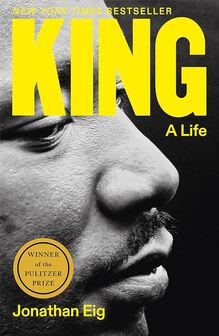
KING: A Life reads as the riveting story his life was, the story of a complex, complicated, compassionate man dedicated to the civil rights movement like no other. I found the book compelling; I couldn’t put it down. I came away better informed, not only about this incredible man and crusader but also about his close relationships, brilliant thinking, strengths and flaws, the history of the times, what King was seeking to accomplish, and all the unfinished work around racism we still need to confront to ensure equitable opportunities and freedom for all of us. Eig provides us with a detailed and balanced portrait of the man—his true greatness and his weaknesses. King was an indefatigable leader not just for civil rights but for human rights. He never lost his clear, moral vision and deeply held beliefs—rooted in the Bible-- even as the federal government was working to destroy him. He suffered severe bouts of depression; he was a womanizer even as he never stopped loving his devoted wife Coretta. He persevered, fighting, non-violently for justice all his life. Even if you don’t read the book, be sure to watch the insightful video interview with Eig, speaking at an author event in Jan. 2024, where he explains his writing process and his key takeaways from all he learned about Martin Luther King Jr.
Jonathan Eig won the 2024 Pulitzer Prize for Biography for KING: A Life, which the judges called “a revelatory portrait of slain civil rights leader Martin Luther King Jr.” Ilyon Woo also won the 2024 Biography Pulitzer for Master Slave Husband Wife: An Epic Journey from Slavery to Freedom. For information on that book see my previous, November 2023 posting in “What I’m Reading” where I elaborate upon that outstanding book. For reviews and more information on KING: A Life, see The New York Times Book Review. In that review by Dwight Garner, he notes “Eig has established his voice. It’s a clean, clear, journalistic voice, one that employs facts the way Saul Bellow said they should be employed, each a wire that sends a current. . . He appears to be so in control of his material that it is difficult to second-guess him.”
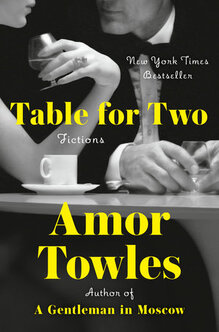
I became an Amor Towles fan after reading his endearing and magnificent A Gentleman in Moscow, still one of my all-time favorite works of fiction. Set in 1920’s Moscow, an aging aristocrat, who is under house arrest for many years at a fancy hotel, still manages to live a meaningful life. In the author’s newest work, Table for Two, Towles applies his storytelling talents to six short stories, which are among the best I’ve ever read. Each of the stories is based in New York City around the year 2000, and each is a stand-alone work of literary art. Each story mostly involves two main characters and the serious conversations and thinking of the two of them, hence the title of the book, Table for Two. Each story centers around topics, such as, as love and marriage, husbands and wives, chance encounters, being in financial straits, human failures, unusual talents. Each story has an unexpected and satisfying ending.
As the mostly, excellent review in The Washington Post asserts, “The only place where Table for Two falters is in the novella that closes it, “Eve in Hollywood.” The review goes on to say the novella “. . . lacks the breezy impetus that makes the shorter pieces fly.” I couldn’t agree more. My advice is to skip the novella. In my opinion, Table for Two feels like a complete book with the six stories. Not all the reviews support that view. For example, The Los Angeles Timesnotes: “This may be Towles’ best book yet. Each tale is as satisfying as a master chef’s main course, filled with drama, wit, erudition and, most of all, heart.” Then the review also lauds the novella: “Eve in Hollywood” is the book’s headliner. It’s a novella that occupies half the book’s 400-plus pages and deserves every bit of that real estate.”
Be sure to watch the fascinating PBS interview with Amor Towles (May 2024) to gain a deep understanding of the author’s writing process. Anyone who teaches fiction writing or writes fiction will gain a wealth of information on how Towles gets his ideas, determines what to write about, decides upon who the narrator will be, what he calls “the most important decision,” and how he builds a world for each book. He believes “We all have the capacity to tell interesting stories.” He also reminds us of the importance of reading novels--that we get to see the world through a new angle and a perspective we haven’t seen or imagined before, which has the power to increase our empathy, imagination, and curiosity.
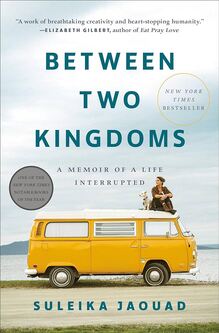
Between Two Kingdoms: A Memoir of a Life Interrupted by Suleika Jaouad is an astonishing book about sickness and health, healing and loss, but also about hope, loving kindness, generosity, courage, and the power of love under the most challenging of circumstances. You cannot read this beautiful, haunting memoir without being changed in some way; your heart and mind will expand as you join Suleika, close up, on her grueling, long-term battles with acute myeloid leukemia and her low chances of survival. But recover from her leukemia she did, twice, each time after a bone marrow transplant. At this writing, she is living a full life even as she faces daily health challenges. In her memoir and publicly, she writes and speaks about reclaiming her life after cancer—living, as she says, between the two kingdoms of sickness and health. In remission, she talks about learning to live as a well person to be a greater challenge than living with cancer. Writing her memoir with honesty, heart, and bravery, the author takes us with her on her continuing journey of healing, self-discovery, and living each day to the fullest.
For much more about Suleika Jaouad and her life, see her inspirational TED talk, “What Almost Dying Taught Me About Living.” Read the excellent National Public Radio review on her memoir. Explore YouTube for many videos about her life and work, including her joyful and loving bond with her husband Jon Batiste--award-winning singer and songwriter. As well, see the inspirational, beautiful Netflix documentary (2023) on how Suleika and Jon aspire to make each day count; and/or see the official trailer for that documentary, American Symphony. For the most comprehensive information on Suleika’s life to date, be sure to read the outstanding article in The Atlantic, June 2024, The Art of Survival by Jennifer Senior, a Pulitzer prize winning writer. Remarkedly, Suleika refuses to let cancer define her. Ultimately, her memoir is a hopeful book. For living our best lives, in spite of uncertainty and fear, Suleika shows us a path forward for facing each day with wonder, awe, and curiosity and for living a fully aware-life between the two kingdoms.
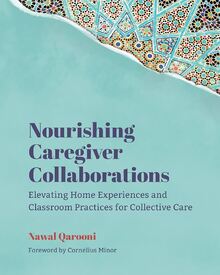
Finally, I want to call out an exceptional professional book: Nourishing Caregiver Collaborations: Elevating Home Experiences and Classroom Practices for Collective Care by Nawal Qarooni. This elegantly written book is a delight to read, full of wonderful stories and practical guidance. And it is beautiful, a work of art and design that includes pieces of the author’s family kalim rugs, handmade tapestries known for their intricate, stunning design, which Nawal connects to the tapestry of life, teaching, and learning. She notes, “. . our tapestry as a learning community is more sturdily and uniquely woven as a result of allowing for each child’s strengths, desires, and specialties to shine”(p. 73.)
The book is set up for study and reflection. Merging family stories and culture with practical ideas for the classroom and the home makes this a one-of-a-kind book, and just the kind that caregivers—family, teachers, friends, and all who are involved in supporting and enriching a child’s life—need. Nawal honors the individuality and different thinking of every learner. She describes how and why the classroom must be a welcoming space for all and how important it is that teachers develop a collective care mindset. Through stories, storytelling and myriad examples, she demonstrates how to honor and include each family’s language, cultural assets, traditions, routines, and strengths to “serve the whole child.” She connects the teaching of literacy with what it means to be human and urges us to keep humanity at the center of our instruction (p.103) She reminds us that children are constantly interacting with the world around them, and we need to bring that observational literacy knowledge into the classroom. In so doing, she expands the definition of what it means to be literate.
Throughout the book, Nawal puts us in the role of the caregiver and guides us with practical and doable suggestions, questions, actions, mindsets, for example, “Questions to ask families and caregivers that celebrate individuality” (p. 89) I love the multiple charts she provides with practical and inclusive ideas for clarifying instruction with and for caregivers. For example, one chart (p. 56) says, “If this is the instructional practice, what might not be clear to caregivers?” Throughout the text, Nawal writes in a warm and encouraging voice that empowers teachers, caregivers, and students. “This book seeks to exalt all families and support all teachers.” (p. 25.) In that goal, it succeeds mightily. Nurturing Caregiver Collaborations describes what it means to be a care-centered teacher and how to elevate caregivers so they are equal partners within the school collective. Nawal Qarooni has written a stunning, groundbreaking, book for us all.
Commentary: The Pleasure of Honoring and Rereading a Favorite Author
I have a lot of bookshelves in my home, and I cherish being surrounded by books and authors I love. My books are not organized in any way except by author, and I have more books by Canadian author Alice Munro than any other author. She wrote 14 short story collections and, in 2023, was the first Canadian woman to receive the Nobel Prize in Literature. When Alice Munro died in May 2024 at the age of 92, there was a flourish of news articles about her life and career in addition to her obituary. She has long been considered the master of the short story and a keen observer of the details of ordinary life. In her New York Times obituary by Anthony DePalma (May 15, 2024), he writes:
“Such details evoke a sense of the semirural Canadian back country, a quiet land where people never deliberately call attention to themselves and the ordinariness of life can be suddenly disrupted by accidents, arrivals and unanticipated events.”
Happily, I own 10 of Munro’s 14 books of short stories; they are lined up next to each other like close siblings, each wanting and meriting attention, affection, and admiration. After Alice Munro died, I went right to her privileged spot on my bookshelf to console myself. It had been years since I’d read her work. Now I could hardly wait to reread some of the superb stories that left me besotted. I started with rereading a couple of stories from her first collection of stories, Dance of the Happy Shades (1968,) which won a prestigious Canadian award, the equivalent of a Pulitzer Prize for fiction. I then moved to Hateship, Friendship, Courtship, Loveship, Marriage (2001) where I reread what is considered one of her finest and most memorable stories, “The Bear Came Over the Mountain,” a story about a husband dealing with is wife’s dementia as she begins a new life in a care facility. And, as is typical in Munro’s stories, there are surprising, unexpected turns of events. For more on her life and writing process, you won’t want to miss the Paris Review interview (1994.) Also, if you go to Vancouver BC, be sure to visit Munro’s Books, a magnificent, independent bookstore she co-founded in 1963 with her first husband. Finally, if you are unfamiliar with Munroe’s stories, you will be richly rewarded by reading any and all of her short story collections.
Rereading a Favorite Book
There is something comforting about re-reading a favorite story or book. You remember parts of it but not all of it. You may view the plot and character development differently, especially if you’ve read a lot of one author or significant time has passed. The fun of re-reading a beloved author should not be restricted, regardless of the age or grade of the reader. Our own children and students find the same kind of satisfaction and comfort as we do in revisiting and getting re-acquainted with a favorite story, text, and author they love. Let’s ensure we give all students the same right and opportunity.
It's important to note that audiobooks are part of rereading too. My book, The Heart-Centered Teacher: Restoring Hope, Joy, and Possibility in Uncertain Times (2024) has an audiobook that I narrate. I’ve personally heard from readers who say that after reading the book, they are now doing a rereading by listening to the audiobook—often when they are going back and forth to work, are on a walk or bike, or are traveling somewhere. As is true for me as well, I love hearing a favorite book in the author’s actual voice. We need to elevate audiobooks as “real books” for all readers. In my latest book,I tell the story of Ted, an adult, up-and-coming reader, for whom audiobooks and repeated reading of favorite texts and passages increased his reading confidence, competency, word solving skills, fluency, and enjoyment. Most often, he listened to the audiobook as he followed along in the print version. Even though he became a capable reader of print, his favorite way to read remained listening to an audiobook. It’s our job to help all readers discover books they love and to encourage them, not discourage them, to reread any favorite book they choose, in any format-- on their own, with a partner, or with a group.